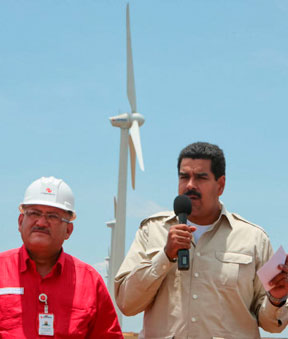
The first attempt to generate renewable energy in Venezuela occurred more than 10 years ago with the construction of a wind farm in La Guajira, in the state of Zulia (west), with a capacity of 10,000 megawatts, a project that was not completed and that has condemned its closest residents to spend, still a decade later, more than 12 hours without electricity.
The project, which began to be built at the beginning of the last decade in alliance with Argentina, is abandoned and “totally inoperative,” according to Alejandro López González, an electrical engineer specializing in renewable energy, explained to EFE.
“Currently the project is abandoned, despite the fact that the development of a first phase, called phase 1A, was achieved. It should be noted that there are 10 phases and phase 1A was barely reached (…) and this was around the year 2012 “, he indicated.
Although this phase was completed, López González pointed out that the lack of coordination and planning of the project prevented it from being incorporated into the electricity grid, “because the interconnection infrastructures and substations were never completed.”
According to data from the NGO Transparencia Venezuela, the Venezuelan State approved 225 million dollars to carry out this work in La Guajira, with an estimated start date of February 2011 and completion for 2013.
That last year, the president of Venezuela, Nicolás Maduro, visited the park facilities, where he approved the construction of phase 1B made up of 36 wind turbines of 2.1 megawatts each, according to the National Electric Corporation (Corpoelec).
TRAFFIC AND VANDALISM
In 2018, the then Minister of Electric Power, Luis Motta Domínguez, denounced that 80% of the “strategic material” of the wind farm was “object of vandalism”.
He also said that of the 12 wind turbines installed so far, there was the possibility of recovering “immediately” 4 of them.
EFE verified that, currently, the facilities are abandoned, without surveillance by State security officials and almost all of the equipment has been stolen or dismantled.
The wind turbines are still there, but without the elevator that was originally installed, without the escalators, without the motors, and some of the blades have fallen to the ground.
In the opinion of López González, this situation is paradoxical because the park had a command of the Bolivarian National Guard (GNB, militarized Police) with the task of protecting the facilities.
“It would be necessary to investigate why, having a GNB command, this wind farm could be looted right under the officers’ noses,” he added.
This fact, he continued, added to the lack of work to finish the work, means for the country the waste of wind energy.
A SUPPORT IN CONTINGENCIES
The residents of the Guajira municipality, mostly indigenous from the Wayúu community, have suffered seasons of daily blackouts, which can last for days. EFE corroborated that there are sectors that register up to two cuts in a day of approximately six hours each.
Similar situations are registered daily in other areas of the country, since, according to data from the Committee of People Affected by Blackouts supplied to EFE at the beginning of this month, electrical service failures in the country increased by 49% in March compared to February.
According to the NGO, Venezuela registered, throughout the past month, 6,043 interruptions in the electrical service, 1,984 more than those documented in February, with the state of Zulia registering the highest incidences with 665 interruptions.
The engineer pointed out that despite the fact that only phase 1A of the wind farm was completed, which represents 5% of the projected total, this would have been enough to satisfy the electrical needs of La Guajira.
The ultimate goal was for it to generate some 10,000 megawatts that, in his opinion, could satisfy the “peak demand” of the entire country, to complement the Simón Bolívar Hydroelectric Power Plant, which is currently the “only source of energy”, for which He points out that this causes that when “there is an event in this plant, there is a lack of electrical service.”
He added that to really take advantage of Venezuela’s potential in renewable energy, legislation focused on technical aspects is necessary, with investment incentives and awareness campaigns for the population.